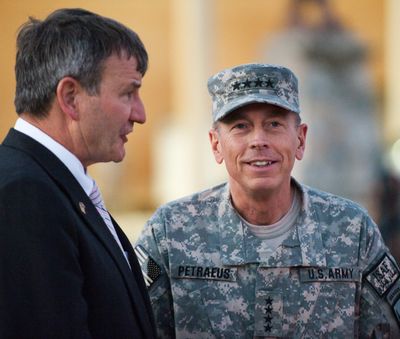Petraeus affirms restrictions
Airstrikes limited as civilian safeguard

WASHINGTON – Afghanistan commander Army Gen. David Petraeus has renewed orders to American troops to refrain from calling in artillery or air power when battling Taliban forces unless they’re certain that no civilians are present.
The Aug. 1 order, Petraeus’ first since he assumed command early this summer from ousted Army Gen. Stanley McChrystal, was an effort to fine-tune a McChrystal directive that had angered some U.S. troops, who said the restrictions on the use of artillery and air power exposed them to greater danger.
Petraeus’ order, unclassified portions of which were released Wednesday, seemed unlikely to mollify that complaint, however.
In his directive, Petraeus sought to strike a balance between protecting the population – the cornerstone of counterinsurgency – and minimizing the risks to U.S. and allied troops.
He wrote that protecting civilians “does not prevent commanders from protecting the lives of their men and women as a matter of self-defense where it is determined no other options are available to effectively counter the threat.”
Petraeus, however, used virtually the same language as McChrystal to prohibit the use of artillery and airstrikes unless a commander knows civilians won’t be wounded or killed.
Before using firepower, “the commander approving the strike must determine that no civilians are present,” Petraeus wrote. “If unable to assess the risk of civilian presence, fires are prohibited” except in two cases that weren’t released because of operational security.
“We must pursue the Taliban tenaciously,” he added. “But we must fight with great discipline and tactical patience.”
Petraeus did make two changes to the rules:
• He ordered U.S. troops to have Afghan security forces with them at all times to make sure civilians aren’t at risk. “Some civilian casualties result from a misunderstanding or ignorance of local customs and behaviors. No individuals are more attuned to the Afghan culture than our Afghan partners,” he wrote to his troops.
• He also called for better training for U.S. troops to know how to apply the rule in ways that don’t put them at risk.
Many U.S. troops in Afghanistan had hoped that Petraeus would give them more room to use air power, the one area in which the U.S. military dominates the Taliban. Petraeus, however, indicated little change from McChrystal’s stance on the issue.
Civilian casualties caused by U.S. and NATO troops dropped significantly after McChrystal’s order, but U.S. troop deaths rose as the U.S. military sent 30,000 more troops into Afghanistan. July, with 66 American deaths, was the deadliest month for U.S. troops in the nine-year war.
Troops are also unlikely to embrace the admonition that Afghan security forces must accompany them on every mission. Currently about 85 percent of combat missions are joint operations, the Pentagon said.
U.S. troops, however, disparage the Afghan forces as poorly motivated, equipped and trained.
There are 98,000 U.S. troops in Afghanistan.